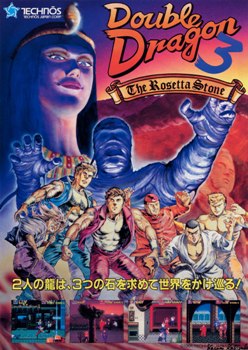This article needs additional citations for verification. (July 2008) |
| Double Dragon 3: The Rosetta Stone | |
|---|---|
 The Japanese brochure from the arcade version, with illustration by Kazumi Kakizaki. | |
| Developer(s) | East Technology Software Creations (Genesis) Sales Curve (Game Boy) |
| Publisher(s) | Technōs Japan Acclaim Entertainment (Game Boy/Genesis)[a] |
| Designer(s) | K. Ichikawa T. Irisawa T. Chida J. Hasepin H. Nagoshi U. Hoshino |
| Programmer(s) | N. Takioka E. Ogura Y. Katsumata |
| Composer(s) | Akira Inoue Takaro Nozaki |
| Series | Double Dragon |
| Platform(s) | Arcade, Amstrad CPC, Amiga, Atari ST, Commodore 64, ZX Spectrum, DOS, Game Boy, Mega Drive/Genesis, iOS, Android |
| Release | |
| Genre(s) | Beat 'em up |
| Mode(s) | Single-player, multiplayer |
Double Dragon 3: The Rosetta Stone[b] is a side-scrolling beat 'em up arcade game produced by Technōs Japan in 1990. It is the third arcade game in the Double Dragon series. Unlike the previous two games in the series, Double Dragon 3 was not developed internally at Technōs, but development was instead contracted to the company East Technology, resulting in a game that looks and plays differently from its predecessors.
As in the previous games of the series, players control twin martial artists Billy and Jimmy Lee, as they are approached by a mysterious fortune teller named Hiruko, who sends them on a worldwide journey to retrieve three mystical Rosetta Stones and uncover the mystery surrounding them in Egypt. Similar to The Combatribes, which ran on similar hardware, the game can be set for up to two or three players depending on the cabinet, with the third player controlling a new Lee sibling named Sonny. The U.S. version also features item shops where players could use additional credits to purchase in-game items such as weapons, additional moves and new playable characters in one of the earliest forms of microtransactions in a video game, although this system would end up being removed in the later-released Japanese version of the game in favor of a conventional character select feature similar to Golden Axe or Final Fight.
The game's arcade release was followed by home versions for the Sega Genesis, Game Boy and various personal computers. In 2013, emulated versions of the arcade original for various platforms were officially released by DotEmu along with the previous two arcade games in a bundle called Double Dragon Trilogy.
- ^ "DOUBLE DRAGON 3". Media Arts Database (in Japanese). Agency for Cultural Affairs. Retrieved 8 July 2021.
- ^ "Double Dragon III: The Rosetta Stone (Registration Number PA0000503225)". United States Copyright Office. Retrieved 8 July 2021.
- ^ Cite error: The named reference
CVGwas invoked but never defined (see the help page).
Cite error: There are <ref group=lower-alpha> tags or {{efn}} templates on this page, but the references will not show without a {{reflist|group=lower-alpha}} template or {{notelist}} template (see the help page).